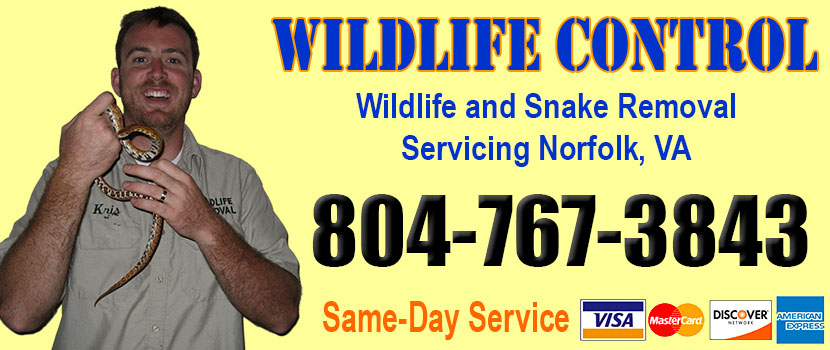
Welcome to norfolksnakes.com! I am David, a snake enthusiast living in Norfolk, VA. Many people don't know that Norfolk is in fact full of snakes! You just need to know where to find them - they can often be shy and elusive. Some Virginia snake species are more common outside of the city limits, in different parts of Norfolk County VA, but many types of snakes are indeed common in the more urban parts of Norfolk. This guide is meant to help educate you about the beautiful snakes of Norfolk, and to help you identify the most common snakes of Norfolk, as well as the venomous snakes of Norfolk that you should learn to recognize and avoid. If you want more detail, click here for my complete list of ALL snake species in Norfolk. Remember the following:
- Most snakes of Norfolk are harmless and don't want to encounter you
- Venomous snakes exist but are uncommon in Norfolk, Virginia
- Snakes eat rats and mice and are a valuable part of the Virginia ecosystem
- Never kill a snake - if you leave a snake alone, it will leave you alone.
Common Snake Species in Norfolk
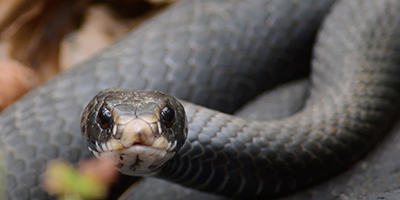 Northern Black Racer:
This particular snake is not just common in Norfolk Virginia, but also a very docile reptile that hardly strikes at anyone. If undisturbed, the northern black racer will come around your home while in search of prey and leave within a few hours. With an average length of about 60 inches, these snakes are slightly larger than every other common snake in Norfolk Virginia.
The northern black racer has a striking dark-colored skin with large prominent eyes that sees clearly during the day time. Due to their body patterns, they are often confused with snakes like the eastern rat snake.
Northern Black Racer:
This particular snake is not just common in Norfolk Virginia, but also a very docile reptile that hardly strikes at anyone. If undisturbed, the northern black racer will come around your home while in search of prey and leave within a few hours. With an average length of about 60 inches, these snakes are slightly larger than every other common snake in Norfolk Virginia.
The northern black racer has a striking dark-colored skin with large prominent eyes that sees clearly during the day time. Due to their body patterns, they are often confused with snakes like the eastern rat snake.
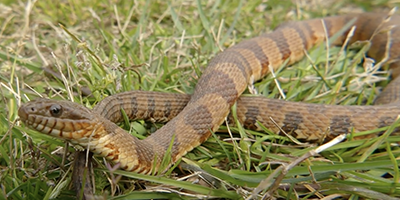 Northern Water Snake:
Though this snake might look exactly like the venomous cottonmouth snake, if you look closely, you will realize their differences. These snakes are usually smaller and less active compared to the former. They will stay hidden in order to avoid a fight as much as they can. Another feature that is common with the northern water snake is their ability to snap and coil up when they feel threatened.
Northern Water Snake:
Though this snake might look exactly like the venomous cottonmouth snake, if you look closely, you will realize their differences. These snakes are usually smaller and less active compared to the former. They will stay hidden in order to avoid a fight as much as they can. Another feature that is common with the northern water snake is their ability to snap and coil up when they feel threatened. 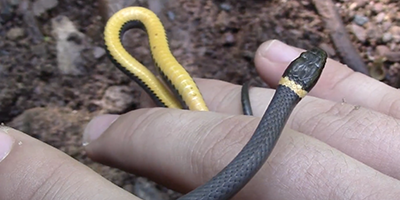 Ring-Necked Snake:
Here is another snake you are most likely going to come across in Norfolk Virginia. They are nocturnal snakes; hence they will never roam around during the day time. Their distinctive skin color allows them to camouflage into their environment to stay hidden during the day.
Ring-Necked Snake:
Here is another snake you are most likely going to come across in Norfolk Virginia. They are nocturnal snakes; hence they will never roam around during the day time. Their distinctive skin color allows them to camouflage into their environment to stay hidden during the day. 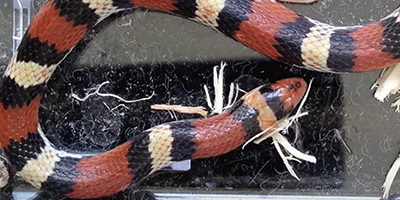 Northern Scarlet Snake:
This particular snake is also very common in Norfolk Virginia. These snakes are small in size and are very secretive. With a maximum length of 20 inches, you can hardly notice their presence if one is around your home. These brown snakes are common in farmlands and gardens
Northern Scarlet Snake:
This particular snake is also very common in Norfolk Virginia. These snakes are small in size and are very secretive. With a maximum length of 20 inches, you can hardly notice their presence if one is around your home. These brown snakes are common in farmlands and gardens Venomous Snake Species in Norfolk
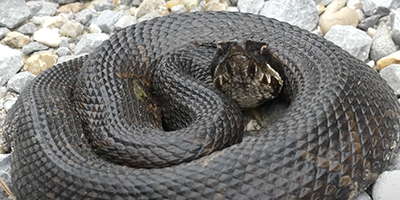 Eastern Cottonmouth:
This snake right here is a reptile that inhabits Norfolk Virginia that you wouldn't want to have an encounter with. The eastern cottonmouth snake grows to an average length of 30 to 48 inches. Although, there have been reports this venomous snake can grow as long as 74 inches. This snake has a distinctive color which is either brown, olive, or black with black crossbands that extend towards the belly region. Also, their head is flattened at the top and triangular.
In Norfolk Virginia, these snakes are usually seen basking on tree stumps, rocks, or logs of wood during the day. Despite being a very deadly snake with lethal venom, these snakes will most likely crawl away if approached. But if bothered, it will stand its ground, coil up, and slowly vibrate its tail. This is a clear indication that it won't hesitate to strike.
Being a snake that likes staying around water bodies, these snakes are capable of swimming in deep waters. To do this, they keep the whole of their body afloat. If you by chance come in contact with this snake, try as much as possible to keep your distance. A single bite from this deadly snake can shut down your nervous system and incapacitate you.
Eastern Cottonmouth:
This snake right here is a reptile that inhabits Norfolk Virginia that you wouldn't want to have an encounter with. The eastern cottonmouth snake grows to an average length of 30 to 48 inches. Although, there have been reports this venomous snake can grow as long as 74 inches. This snake has a distinctive color which is either brown, olive, or black with black crossbands that extend towards the belly region. Also, their head is flattened at the top and triangular.
In Norfolk Virginia, these snakes are usually seen basking on tree stumps, rocks, or logs of wood during the day. Despite being a very deadly snake with lethal venom, these snakes will most likely crawl away if approached. But if bothered, it will stand its ground, coil up, and slowly vibrate its tail. This is a clear indication that it won't hesitate to strike.
Being a snake that likes staying around water bodies, these snakes are capable of swimming in deep waters. To do this, they keep the whole of their body afloat. If you by chance come in contact with this snake, try as much as possible to keep your distance. A single bite from this deadly snake can shut down your nervous system and incapacitate you.
If you're unsure, you can email me a photo of the snake at info@norfolksnakes.com and I will email you back with the snake's species. If you found a snake skin, read my Found a Skin? page, and you can email me a photo of the skin, and I'll identify the snake for you. If you need professional Norfolk snake removal help, click my Get Help page, or see the below website sponsor I found, who provides that service.
Evidence that Snakes Also Feel Pain
Snakes are unique and fascinating creatures. They are beautiful, yet they have earned a negative reputation for being deadly. Some people have feared the existence of this animal. However, there are more reasons why these snakes will fear us more. They look at us as a huge predator and will immediately flee once they encounter us. In Southeast Asia, around 400,000 pythons will be slaughtered annually to harvest their skin and turn them into human accessories. These are only the numbers accounted for; the real number can be higher.
Can Snakes Feel Pain?
Most of the killed snakes will be removed from their natural home. They will be hunted in the forest of Malaysia and Indonesia. Once they have been captured, their head will be decapitated using a machete. Snakes have a very slow metabolism. Therefore, it will take a long time before they die, even after their head has been severed from their body. They can also be nailed on a tree, tied upside down before being beaten and bludgeoned to death.
In some cases, the snake's jaws will be opened forcefully. A tube will then be inserted inside their throats, and they will fill the snake's bodies with water. This procedure will make it easy to remove the snake's skin. Their necks will be tied securely using a rope to prevent any waters from spilling over. They will be left here in this state for 10 minutes, bloated and dying slowly.
What Are Some Proofs that Snakes Feel Pain?
Health scientists and veterinarians will often have the notion that reptiles will not feel any pain. Initially, they will simply put them inside the freezer and wait for them until they die. We have deluded ourselves that snakes will not feel any pain during the process. We believe that their lack of response is an indication that they don't experience any suffering. We thought that they would only mechanically react to any pain stimulus; thus, making them unable to feel pain, unlike humans.
However, this is entirely untrue. Just because the reaction they show is more subtle doesn't mean that they can no longer feel pain. Scientists have discovered that all reptiles have neurotransmitters and the right anatomy to experience agony and pain. According to them, it is highly likely that these creatures have evolved to hide their pain and weakness when in the presence of a predator. Moreover, veterinarians that have been administering pain-relief medicines for pet snakes have reported a noticeable clinical effect.
The idea that the snake may feel pain may help you see the animals in a different light. Just like any living being, these animals are capable of experiencing suffering. Unfortunately, they are being harvested by humans to create fashion accessories. Snakes are beneficial to our environment and are mostly harmless. They can manage the population of rodents and insects that destroys our crops. We need to give them a chance to survive by leaving them alone in their natural environment.
Remember, the term is not poisonous snakes of Norfolk, it's venomous snakes of Norfolk. Poison is generally something you eat, and venom is injected into you. That said, dangerous snakes are very rare in Norfolk. The few venomous snakes of Norfolk County are rarely seen. But they are commonly misidentified, so learn about all the snake species of Norfolk in order to correctly identify them. These snakes are usually also found in the surrounding towns of Bellingham, Braintree Town, Brookline, Dedham , Dover, Foxborough, Franklin Town, Holbrook, Medfield, Millis-Clicquot CDP, Milton, Needham, Norwood, Quincy, Randolph, Sharon, Walpole, Wellesley and the surrounding areas.
Read our article about:
How Do Snakes Communicate with Each Other?
norfolksnakes.com domain and hosting costs made possible by the generous support of this sponsor:
